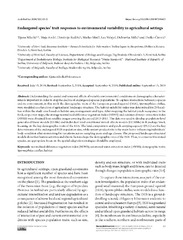Приказ основних података о документу
Endangered species’ trait responses to environmental variability in agricultural settings
| dc.creator | Nikolić, Tijana | |
| dc.creator | Arok, Maja | |
| dc.creator | Radišić, Dimitrije | |
| dc.creator | Mirč, Marko | |
| dc.creator | Velaja, Lea | |
| dc.creator | Milić, Dubravka | |
| dc.creator | Ćirović, Duško | |
| dc.date.accessioned | 2020-04-29T12:23:27Z | |
| dc.date.available | 2020-04-29T12:23:27Z | |
| dc.date.issued | 2020 | |
| dc.identifier.issn | 0354-4664 | |
| dc.identifier.uri | http://www.serbiosoc.org.rs/arch/index.php/abs/article/view/4485 | |
| dc.identifier.uri | https://radar.ibiss.bg.ac.rs/handle/123456789/3654 | |
| dc.description.abstract | Understanding the spatial and temporal effects of variable environmental conditions on demographic characteristics is important in order to stop the decline of endangered-species populations. To capture interactions between a species and its environment, in this work the demographic traits of the European ground squirrel (EGS), Spermophilus citellus, were modeled as a function of agricultural landscape structure. The habitat suitability index was determined for 20 localities within the study area based on habitat use, management and type. After mapping the habitat patch occupancy in the field, crop cover maps, the average normalized difference vegetation index (NDVI) and automated water extraction index (AWEI) were obtained from satellite images covering the period 2013-2015. This data was used to develop population-level generalized linear models (GLMs) and individual-level conditional mixed-effects models (GLMMs) in R package Ime4, focusing on the key demographic traits of the EGS. The land composition and patch carrying capacity (PCC) are the key determinants of the endangered EGS population size, while system productivity is the main factor influencing individuals’ body condition after monitoring for variations across sampling years and age classes. The proposed landscape structural models show that human activities and abiotic factors shape the demographic rates of the EGS. Thus, to conserve threatened species, an appropriate focus on the spatial adaptation strategies should be employed. | en |
| dc.relation | info:eu-repo/grantAgreement/MESTD/Integrated and Interdisciplinary Research (IIR or III)/43002/RS// | |
| dc.relation | Rufford Foundation | |
| dc.relation | Provincial Secretariat for Science and Technological Development (142-451-2591/2017) | |
| dc.rights | openAccess | |
| dc.rights.uri | https://creativecommons.org/licenses/by-nc-nd/4.0/ | |
| dc.source | Archives of Biological Sciences | |
| dc.subject | Normalized difference vegetation index (NDVI) | |
| dc.subject | Automated water extraction index (AWEI) | |
| dc.subject | Demographic traits | |
| dc.subject | Spermophilus citellus | |
| dc.subject | Habitat | |
| dc.title | Endangered species’ trait responses to environmental variability in agricultural settings | en |
| dc.type | article | en |
| dc.rights.license | BY-NC-ND | |
| dcterms.abstract | Мирч, Марко; Николић, Тијана; Aрок, Маја; Велаја, Леа; Ћировић, Душко; Милић, Дубравка; Радишић, Димитрије; | |
| dc.rights.holder | © 2020 by the Serbian Biological Society. | |
| dc.citation.issue | 1 | |
| dc.citation.volume | 72 | |
| dc.identifier.doi | 10.2298/abs190715061n | |
| dc.identifier.scopus | 2-s2.0-85086791593 | |
| dc.identifier.wos | 000524505000002 | |
| dc.citation.apa | Nikolić, T., Arok, M., Radišić, D., Mirč, M., Velaja, L., Milić, D., et al. (2020). Endangered species’ trait responses to environmental variability in agricultural settings. Archives of Biological Sciences, 72(1), 13–21. | |
| dc.citation.vancouver | Nikolić T, Arok M, Radišić D, Mirč M, Velaja L, Milić D, Ćirović D. Endangered species’ trait responses to environmental variability in agricultural settings. Arch Biol Sci. 2020;72(1):13–21. | |
| dc.citation.spage | 13 | |
| dc.citation.epage | 21 | |
| dc.type.version | publishedVersion | |
| dc.identifier.fulltext | https://radar.ibiss.bg.ac.rs/bitstream/id/6129/ABS-72-1-013-021.pdf | |
| dc.citation.rank | M23 |

